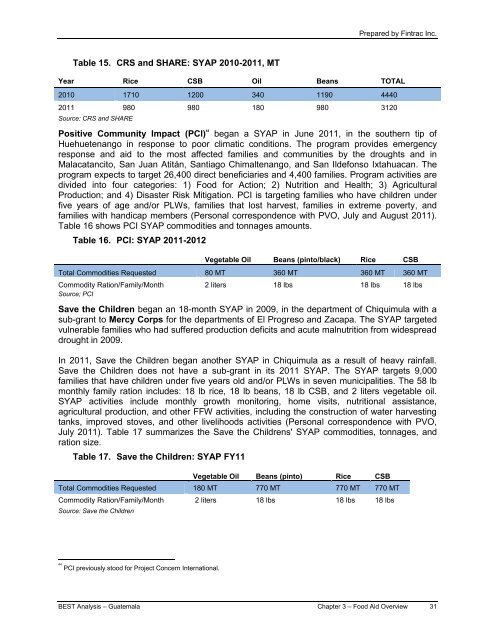usaid office of food for peace guatemala bellmon estimation
usaid office of food for peace guatemala bellmon estimation
usaid office of food for peace guatemala bellmon estimation
You also want an ePaper? Increase the reach of your titles
YUMPU automatically turns print PDFs into web optimized ePapers that Google loves.
Table 15. CRS and SHARE: SYAP 2010-2011, MT<br />
Prepared by Fintrac Inc.<br />
Year Rice CSB Oil Beans TOTAL<br />
2010 1710 1200 340 1190 4440<br />
2011 980 980 180 980 3120<br />
Source: CRS and SHARE<br />
Positive Community Impact (PCI) 44<br />
began a SYAP in June 2011, in the southern tip <strong>of</strong><br />
Huehuetenango in response to poor climatic conditions. The program provides emergency<br />
response and aid to the most affected families and communities by the droughts and in<br />
Malacatancito, San Juan Atitán, Santiago Chimaltenango, and San Ildefonso Ixtahuacan. The<br />
program expects to target 26,400 direct beneficiaries and 4,400 families. Program activities are<br />
divided into four categories: 1) Food <strong>for</strong> Action; 2) Nutrition and Health; 3) Agricultural<br />
Production; and 4) Disaster Risk Mitigation. PCI is targeting families who have children under<br />
five years <strong>of</strong> age and/or PLWs, families that lost harvest, families in extreme poverty, and<br />
families with handicap members (Personal correspondence with PVO, July and August 2011).<br />
Table 16 shows PCI SYAP commodities and tonnages amounts.<br />
Table 16. PCI: SYAP 2011-2012<br />
Vegetable Oil Beans (pinto/black) Rice CSB<br />
Total Commodities Requested 80 MT 360 MT 360 MT 360 MT<br />
Commodity Ration/Family/Month 2 liters 18 lbs 18 lbs 18 lbs<br />
Source; PCI<br />
Save the Children began an 18-month SYAP in 2009, in the department <strong>of</strong> Chiquimula with a<br />
sub-grant to Mercy Corps <strong>for</strong> the departments <strong>of</strong> El Progreso and Zacapa. The SYAP targeted<br />
vulnerable families who had suffered production deficits and acute malnutrition from widespread<br />
drought in 2009.<br />
In 2011, Save the Children began another SYAP in Chiquimula as a result <strong>of</strong> heavy rainfall.<br />
Save the Children does not have a sub-grant in its 2011 SYAP. The SYAP targets 9,000<br />
families that have children under five years old and/or PLWs in seven municipalities. The 58 lb<br />
monthly family ration includes: 18 lb rice, 18 lb beans, 18 lb CSB, and 2 liters vegetable oil.<br />
SYAP activities include monthly growth monitoring, home visits, nutritional assistance,<br />
agricultural production, and other FFW activities, including the construction <strong>of</strong> water harvesting<br />
tanks, improved stoves, and other livelihoods activities (Personal correspondence with PVO,<br />
July 2011). Table 17 summarizes the Save the Childrens' SYAP commodities, tonnages, and<br />
ration size.<br />
Table 17. Save the Children: SYAP FY11<br />
Vegetable Oil Beans (pinto) Rice CSB<br />
Total Commodities Requested 180 MT 770 MT 770 MT 770 MT<br />
Commodity Ration/Family/Month 2 liters 18 lbs 18 lbs 18 lbs<br />
Source: Save the Children<br />
44<br />
PCI previously stood <strong>for</strong> Project Concern International.<br />
BEST Analysis – Guatemala Chapter 3 – Food Aid Overview 31

















